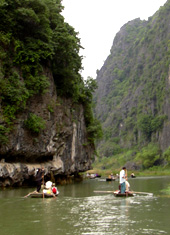 |
||||||||||||||||||||||||||||
|
From Ha Noi to Ninh Binh province is 93km on National Highway 1. Ninh Binh has various landscapes because of its proximity to the mountains of Non Nuoc and Canh Dieu. These are some tourist attractions of Ninh Binh: * Hoa Lu Ancient Royal Capital : In 968, Dinh Bo linh ascended to the throne and took the name of King Dinh Tien Hoang. The country was named Dai Co Viet. Because of its half-mountain half-plain topography, Hoa Lu was chosen as royal capital during 41 years (968-1009). Twelve years were spent under Nha Dinh (Dinh Dynasty), and the remaining 29 years were under Nha ien Le (Pre-Le Dynasty) beginning with King Le Dai Hanh. King Le Dai Hanh was credited with building many palaces and made the royal capital more beautiful and magnificent. In 1010, Ly Thai To moved the royal capital of Hoa Lu to Thang Long. Nowadays, tourists can see two temples some 500m apart of each other : One in dedication to King Dinh Tien Hoang and the other to King Le Dai Hanh. On the 10th day of the lunar third month each year, a great number of pilgrims come to Hoa Lu to pay tributes to Kings Dinh and Le *Bich Dong is a grotto located in the Ngu Hanh Son mountain range, Minh Hai commune, Hoa Lu district. In the 18th century, King Tu Duc visited Bich Dong. Charmed by the marvelous scenery offered by the mountains, rivers and pagodas, the king conferred on Bich Dong the title "The second most beautiful grotto in Vietnam". *Cuc Phuong National Park covers an area of 25,000ha, three quarters of which are limestone mountains. This primeval tropical forest was discovered in 1960, and turned into a national park two years later. Cuc Phuong is famous for dozens of picturesque caves. The most interesting of them is ��ng Nguoi Xua (Ancient Man Cave) where stone tools of prehistoric humans were found. The National Park is home to some 2,000 species of flora. It is also home to 262 species of animals, birds and reptiles, including elephants, tigers, deer, flying squirrels, flying lizards and boas. *Phat Diem Cathedral was built in 1875-1898 in Luu Phuong commune, Kim Son district. This cathedral is an architectural complex that combines the traditional pagoda architecture of Vietnam and the Gothic style of Christian architecture. *Tam Coc literally means 'Three caves' and is actually a combination of three caves: First, Second and Third or Hang Ca, Hang Hai and Hang Ba respectively. They are to be found in Ninh Hai village of Hoa Lu district, Ninh Binh province, just 100 km Southeast of Ha Noi. The only entrance to the compound with the three caves is a three-hour long waterway starting from Dinh Cac in Van Lam village. Having left the roadway, one is greeted by hundreds of small boats waiting to take visitors to Tam Coc. Sitting on boat enroute to Tam Coc, one is enclosed by the scenic beauty of huge rocks standing along the river and scattered green rice fields, all combining to form a poetic painting of the countryside. An early morning ride only adds to this scene a thick layer of fog, making one wonder if this is indeed earth or Heaven? A 2-km ride from Van Lam would take you to Hang Ca where you are welcomed by a real rainbow in the water if it is morning time. The sun after rising high above Hang Mua (Cave of Dance) creates this effect which pull one's mind away from reality into a dream world. The rocks eaten by sea water over thousands of years have been carved into a series of caves here. Although the sea is far away from the locality, now the caves remain. Rainwater has helped to polish the caves and start up underground rivers. Hang Ca (the First Cave) is 127 m long under a big mountain stretching on both sides of the Ngo Dong river. The river, having met the mountain, enters it through the cave. Only nature could produce such a miracle. The quiet movements of the oars create a sort of musical rhythm inside the cave. As the boat leaves the cave, one is startled to see what seems to be an old man with a white beard fishing. High above is fairy flying in the clouds. The picture is completed by some peasants collecting fuel and a group of white goats grazing on the hills. As the boat moves, visitors approach Hang Hai (the Second Cave). Not less beautiful, the undisturbed water reflects the details of the flowers and trees and rocks alongside its banks as well as the blue sky and white clouds above. The cave is thus full of water and clouds. Only a hundred metres away is Hang Ba (the Third Cave) which is the coolest of the caves due to its lower formation. The attraction here is the natural light inside the cave reflected by the water. The huge and even rocks lying in the stream provide excellent platforms for those who wish to bathe in the waters. Legend has it that the fairies bathed here once and thereafter the stream has been called Suoi Tien. Whether it is true or not, a bath in the wild with the sounds from the jungle and the fragrance of wild flowers is certainly an experience one would not like to miss.-- VNS
The Canh Dieu (Wings of a Kite) is a mythical mountain range situated east of Ninh Binh provincial town, 90km south of Ha Noi and is associated with the incarnation of Cao Bien, a talented general and magician of the Duong Dynasty. He was often seen flying a paper kite, spying on and destroying the favourable Germanic features of the country. He was downed once and for all by a highly capable Taoist hermit and his broken wings are said to have crashed into the mountain, hence the name Canh Dieu (Wings of a Kite). The mountain range comprises three peaks, the highest in the middle, the other two on both sides spreading just like the wings of a flying hawk. The erudite LeQu� Don (1726-1784), from Thai Binh, had the following poem inscribed on the eastern cliff: A deep-blue rock juts out of the plains, The mountain looks just like a flying hawk. A pagoda is up there perched high Among the three mountain toys The river spanned by a bridge. The mountain is as firm as a sitting tiger The stream winds like a dragon." It is certainly a Wonderland with caves and breath-taking views. In 1821, King Minh Mang (1820-1840), on a north-bound trip, made a stop-over at the mountain and had the following inscription carved on the northern cliff: "A small house rests at the foot of the mountain, A towered pagoda frowns from atop the fortress Sailboats drift slowly along the river. It was a painting. I bent down to wash the "life-dust"coat. Back in the capital, the King dwelt at length on "life dust" agriculture and designed a land-reclaiming policy, of which Nguyen Cong Tru was put in charge. By late 1829, the latter had mobilised the population to reclaim about 14620 mau (1 mau = 360 sq.m) and a new district, Kim Son (mountain of gold), was established. A densely-populated area was also picked out by Nguyen Cong Tru and given the name Phat Diem (where Beauty comes from). Legend has it that Phat Diem had a story behind it. Passing through Ninh Binh provincial town, Nguyen Cong Tru "discovered" the likeness of a bare-chested young girl, lying full-length on her back, looking up at the boundless heaven, so chaining the mountain to her. The mountain was thus given the name Ngoc My Nhan (The Beauty of a Pearl). The head of the beautiful girl faces the East Sea, in the territory of Kim Son, meaning "Beauty comes from there". Thus the mountain has thus come to have two names - "Wings of a Kite" mountain and "The Beauty of a Pearl" -- two names associated with two beautiful legends. (VNS)
|
|||||||||||||||||||||||||||
Copyright 2000 - 2020, Vietnam Opentour International Tour Operator License No 01-014/20 14/TCDL - GPLHQT by Vietnam National Administration of Tourism All rights reserved Hanoi :85-87 Hoang Quoc Viet - Hanoi - Vietnam Tel :(+84.24).3 8364212 -3 7568868 - Fax : (+84.24).37567862 Hochiminh city : Suite 403, Floor 4th, 134 Cao Thắng, District 3, Hochiminh city, Vietnam. Tel : (+84.28).62729925 - 38334083 Email : [email protected]
|
||||||||||||||||||||||||||||

